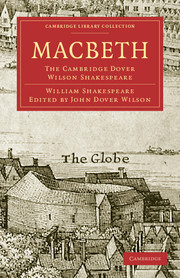THE COPY FOR MACBETH, 1623
Published online by Cambridge University Press: 07 September 2010
Summary
‘One of the worst printed of all the plays’ is the verdict of the Cambridge editors of 1865 on the F. Macbeth; and, enlarging upon this in their ‘Clarendon’ text seven years later, they observe that it was probably ‘printed from a transcript of the author's MS., which was in great part not copied from the original but written to dictation’; while in both editions they insist upon the irregularity of the verse lineation. Modern experts are less pessimistic. ‘Macbeth is doubtless printed from a prompt-copy’ declared Sir Edmund Chambers in 1930. Dr Greg, expanding this in 1942, notes that ‘the directions are normal and reveal the hand of the book-keeper though some probably originated with the author’. Expanding it still further, I would add that, as we have two authors to deal with in Macbeth, the F. stage-directions, while basically Shakespeare's, are likely to contain additions and alterations by Middleton, together with some by the book-keeper, who had of course the final word. A couple of duplicated directions are illuminating in this connexion. At 2. 3. 80, it seems pretty clear that the author, here probably Shakespeare, wrote ‘Bell rings. Enter Lady’, that the prompter added ‘Ring the Bell’ on his own account in the margin, and that these three words, happening to stand opposite to half a line of verse at the end of Macduff's speech, were taken by the F. compositor as completing the line and set up accordingly.
- Type
- Chapter
- Information
- MacbethThe Cambridge Dover Wilson Shakespeare, pp. 87 - 91Publisher: Cambridge University PressPrint publication year: 2009First published in: 1947



